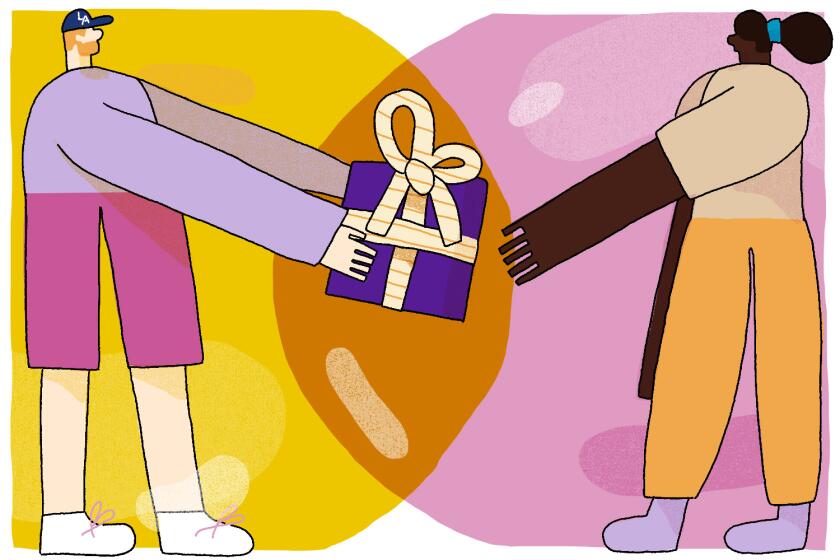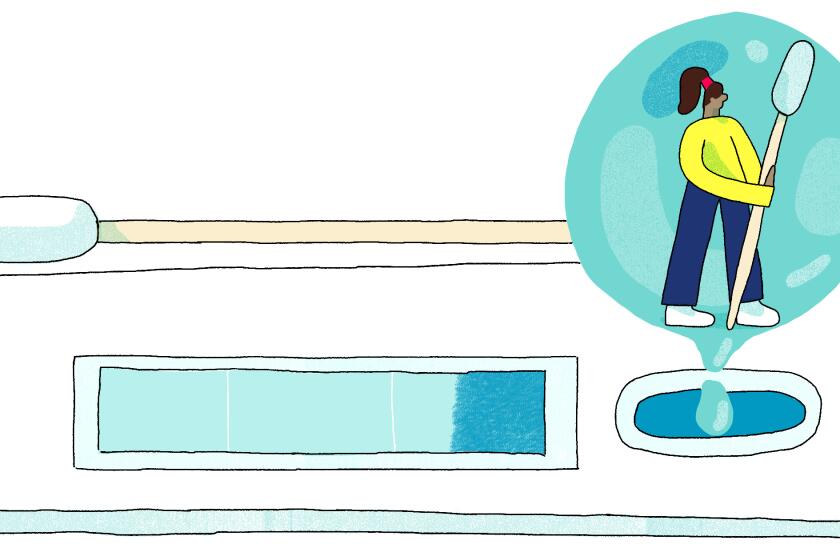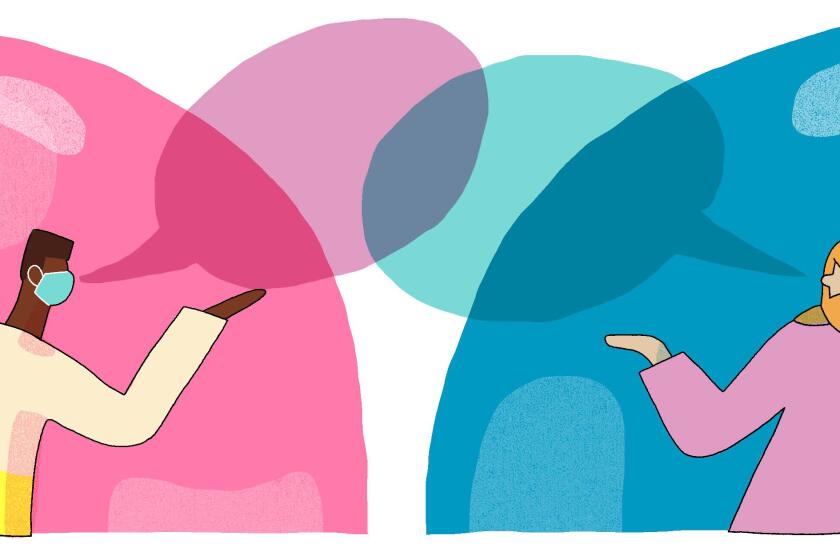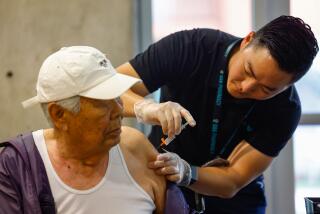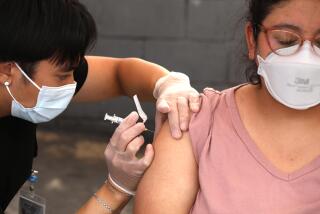8 COVID precautions you can leave behind this holiday season
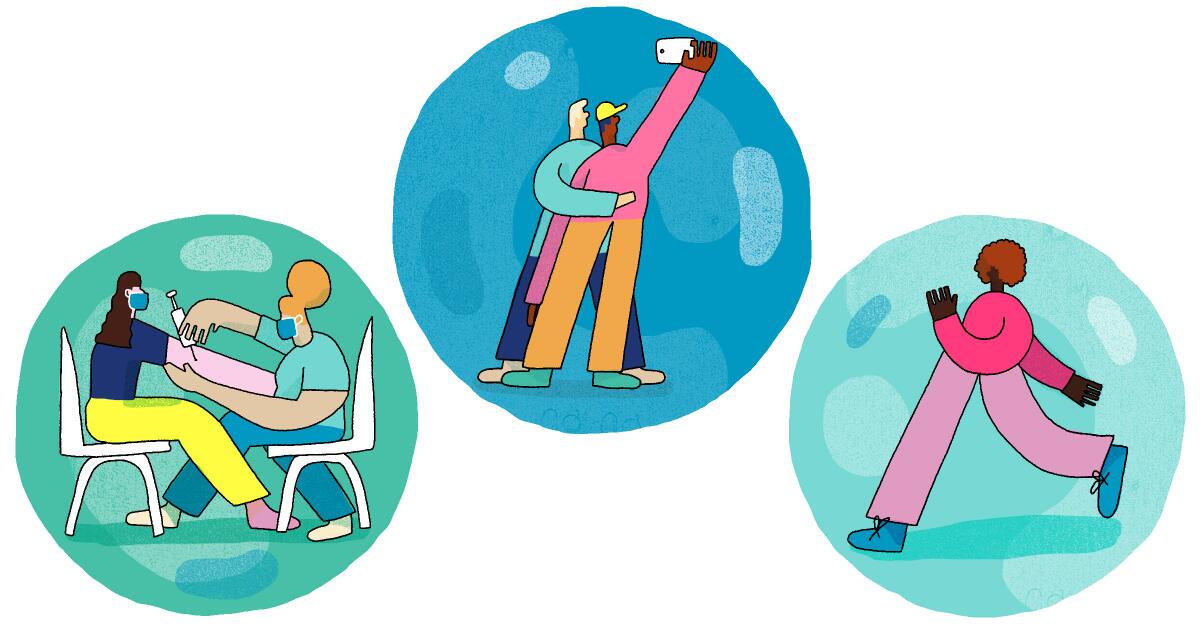
- Share via
Our second holiday season under the shadow of COVID-19 is right around the corner. And though the pandemic isn’t over and it’s still important to take precautions, this year, many are vaccinated, so we’re in a better starting place than we were last year.
Gone are the days when we knew nothing about the coronavirus — and therefore needed to be vigilant about everything.
We now know the primary way that people are infected is through exposure to respiratory fluids carrying infectious virus. This means:
- Inhaling air that contains the virus;
- The virus being exhaled onto your mucous membranes (a.k.a. someone coughing on you);
- Touching small droplets or particles of the virus with your hands and then touching your nose, eyes or mouth.
What does that mean for the stuff we used to do that we might not have to do anymore? The stuff we used to be scared of that might not be as scary anymore?
It’s time for a reset on our COVID-19 worry meter — as well as a word of encouragement to keep up with the latest announcements from the Centers for Disease Control and Prevention, your local health officers and trusted medical professionals — so that worrying less can come more than once a year.
The 2021 holidays will be much different from 2020 thanks to the COVID-19 vaccines. But we aren’t quite back to normal. Here’s what you should know.
Eight things we can stop worrying about
1. Wiping down every surface at least once a day
Remember when we thought we needed to use Lysol wipes to disinfect packaged groceries and takeout containers?
We’ve since learned that the coronavirus doesn’t survive well on surfaces, so there is a low risk of spread from food products or packaging. The CDC says that it’s probably not necessary to do any extra disinfecting in general unless someone who has been in your home within the last 24 hours has a confirmed coronavirus infection. If you continue to clean your home regularly — easier said than done, sometimes — regular soap and detergents remove most virus particles on surfaces just fine.
But if anyone in your household is more likely to get very sick from COVID-19, it doesn’t hurt to clean more often. And be sure to wash your hands often.
2. Wearing gloves
Remember when we wore gloves to use the gas pump, which we imagined hundreds of possibly infected people had touched before us?
The CDC now says that for the general public, gloves are not necessary unless you are cleaning or caring for someone sick. The best way to protect yourself from germs after going out is by regularly washing your hands or using hand sanitizer.
But please continue wearing your cute black gloves on your lunchtime stroll, because it’s cold in California when it’s (below 70 degrees!), and we need to stave off seasonal affective disorder now that it gets dark by 5 p.m.
Add some rapid COVID-19 tests to your holiday shopping list. Once you’ve got them, here’s what you should know about how, when and why to use them ahead of Thanksgiving, Hanukkah, Christmas or other holiday gatherings.
3. Handshakes
Remember when we thought we’d never shake hands ever again?
It’s still true that if someone has a coronavirus infection, coughs on their hand and shakes your hand — and then you put your hand near your nose, eyes or mouth — you might get infected. But if they aren’t infected, or they don’t cough on their hand, or if you wash your hands before rubbing your hands all over your face, then you should be OK.
But don’t feel pressured to start shaking hands again if you thought the elbow tap was so much cooler.
4. Masks worn outside
In general, outdoor activities are safer than indoor ones because increased airflow means you’re less likely to encounter concentrations of the virus in the air.
According to CDC guidelines, you do not need to wear a mask in most outdoor settings, especially if you continue to practice social distancing. The exception is if you’re in an area where coronavirus transmission rates are high, or if you’re participating in activities where you’ll be in close contact with others who are not fully vaccinated, or if you’re in a large crowd.
Some public health officers, like Santa Clara County’s, still recommend the use of face coverings if you are in crowded areas in general. Los Angeles County mandates masks outdoors at events with 10,000 or more people and recommends them in some other outdoor situations. And it’s worth remembering that most young kids are still not fully vaccinated and that people who have weakened immune systems should take all precautions recommended for unvaccinated people.
5. Sharing food
R.I.P. Souplantation, but was that overkill (and is reincarnation real?) now that we understand that buffets and sharing food family-style are not big COVID-19 risks?
Eating meals together can still be risky — especially if you’re indoors and not vaccinated — because the act of chewing can spread coronaviruses through respiratory droplets and aerosols. But there’s currently no evidence that COVID-19 is transmitted through food. So if you’ve already decided to eat together, it’s fine to split a dessert without worrying about getting separate plates.
A lot of other germs can be transmitted by sharing food. But this is not a story about other germs.
This is the second holiday season amid the COVID-19 pandemic. Here’s what to consider before you get together with family and friends to celebrate.
6. Water-based activities
Remember when we shamed people for going to the beach?
Not only do we now know that it’s safer to be outside than inside but we also understand that the virus doesn’t spread through water. That includes swimming pools, hot tubs and water playgrounds.
If you get close enough for someone who is infected to breathe on you in a hot tub, that’s one thing. But if you’re swimming several feet away from anyone who has COVID-19, you’re probably fine.
7. Saving good-quality masks for healthcare workers
Remember when we thought we needed to make masks out of socks, handkerchiefs or underwear so we could save the N95 masks for healthcare workers? (Kind of like how Jing-mei in “The Joy Luck Club” took the worst-quality crab because she had the best-quality heart?)
Healthcare workers now are fully supplied with masks, and, fingers crossed, it will stay that way. So feel free to buy KN95s and other high-quality disposable face masks. The CDC also recommends masks with two or more layers of washable, breathable fabric that fit snugly on your face.
8. Long lines (or impossible hurdles) to get vaccine appointments
Remember when you used your BTS-concert-ticket-snagging skills to get your elderly family members and friends those coveted vaccine appointments? And then they had to wait an hour in line to get inoculated?
Now you can waltz into most pharmacies and clinics for COVID-19 vaccinations, even without an appointment. Everyone age 5 and over is now eligible to get a shot. California also is recommending booster shots for everyone who wants them, to provide extra protection for people before holiday travel and get-togethers, and those appointments are easy to make as well.
If you and everyone else in your circle are vaccinated, worrying less just might become your new normal.
It’s OK to ask about vaccination status and have hard conversations with family about holiday gatherings and COVID safety. Just do it with respect. Here’s how.
More to Read
Sign up for The Wild
We’ll help you find the best places to hike, bike and run, as well as the perfect silent spots for meditation and yoga.
You may occasionally receive promotional content from the Los Angeles Times.
